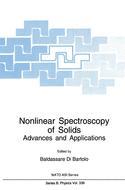Description
Nonlinear Spectroscopy of Solids, 1994
Advances and Applications
NATO Science Series B: Series, Vol. 339
Coordinator: di Bartolo Baldassare
Language: English
Keywords
Publication date: 07-2013
635 p. · 15.5x23.5 cm · Paperback
635 p. · 15.5x23.5 cm · Paperback
Description
/li>Contents
/li>
This report presents an account of the course "Nonlinear Spectroscopy of Solids: Advances and Applications" held in Erice, Italy, from June 16 to 30, 1993. This meeting was organized by the International School of Atomic and Molecular Spectroscopy of the "Ettore Majorana" Centre for Scientific Culture. The purpose of this course was to present and discuss physical models, mathematical formalisms, experimental techniques, and applications relevant to the subject of nonlinear spectroscopy of solid state materials. The universal availability and application of lasers in spectroscopy has led to the widespread observation of nonlinear effects in the spectroscopy of materials. Nonlinear spectroscopy encompasses many physical phenomena which have their origin in the monochromaticity, spectral brightness, coherence, power density and tunability of laser sources. Conventional spectroscopy assumes a linear dependence between the applied electromagnetic field and the induced polarization of atoms and molecules. The validity of this assumption rests on the fact that even the most powerful conventional sources of light produce a light intensity which is not strong enough to equalize the rate of stimulated emission and that of the experimentally observed decay. A different situation may arise when laser light sources are used, particularly pulsed lasers. The use of such light sources can make the probability of induced emission comparable to, or even greater than, the probability of the observed decay; in such cases the nonlinearity of the response of the system is revealed by the experimental data and new properties, not detectable by conventional spectroscopy, will emerge.
Fundamentals of Nonlinear Spectroscopy: Intrinsic Nonlinearity of the Interaction between Radiation Fields and Atoms; D. Di Bartolo. The Spin-photon Echo Revisited; E.L. Hahn. Nonlinear Spectroscopy of Inorganic Materials: Excitons in Semiconductors; J.M. Hvam. High Resolution Nonlinear Spectroscopy of Rare Earth Ions in Solids; R. Macfarlane. Advances in Solid State Lasers; A.I. Ferguson. Quantum Noise in Parametric Amplification; I. Abram, J.A. Levenson. Two and Three Photon Spectroscopy of Solids; D. Fröhlich. Nonlinear Spectroscopy of the Electron-Hole Plasma in Semiconductors; C. Klingshirn. The Two Photon Laser; D. Gauthier, H. Concannon. Optical Nonlinearities of Color Centers in Alkali Halides; C. Baldacchini. Electronic and Optical Properties of Lower-dimensional Semiconductor Systems; D.A. Broido. Special Seminars: Cold Fusion Four Years Later; F. Scaramuzzi. Science and Technology and Theology: Scientific Mentality and Christian Faith; G. Koch. Short Seminars: Capturing a Phase Transition: The Dielectric Constant of GaAs Following an Intense Ultrashort Optical Excitation; E. Glezer. Second Harmonic Generation of MOVPE ZnTe Waveguides; H. Wagner. Posters: Threshold Behavior of Microcavity Lasers; D. Boggavarapu. Low Frequency Raman Scattering from Thermally Treated Oxide Glasses; K. Lipinska-Kalita. 38 additional articles. Index.
© 2024 LAVOISIER S.A.S.
These books may interest you

Progress in Nanophotonics 3 52.74 €



